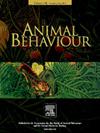Directional biases and individual differences in foraging strategies in Apis mellifera
IF 2.1
2区 生物学
Q2 BEHAVIORAL SCIENCES
引用次数: 0
Abstract
Brain lateralization affects behaviour in both vertebrates and invertebrates, with population-level lateralization being advantageous in some contexts (e.g. mating) and individual-level lateralization beneficial in others. However, the specific contexts where this occurs in some species remain underexplored. In foraging, individual lateralization may aid in resource distribution, reducing overlap. This study investigates whether honey bees, Apis mellifera, show directional biases during a foraging task in an artificial meadow and how this affects their trajectories and foraging efficiency. Twenty bees from four colonies foraged from 16 artificial flowers arranged in a 4 × 4 grid. We measured their overall directional biases in visiting (and revisiting) flowers and in the first flower choices over 16 trials. Moreover, we analysed foraging consistency and efficiency. An overall rightward population level was observed across trials. When analysing only the first flower choices, seven bees showed significant lateral biases (three favouring right and four left). Foraging efficiency, measured by time and trajectories, showed no clear pattern; only two lateralized individuals showed faster times and more consistent paths than nonlateralized bees. The results suggest that individual lateralization may not significantly impact foraging efficiency but could be advantageous for colony resource distribution. For all bees, whether lateralized or not, there was a strong correlation between trajectory similarity and foraging time: the more consistent the paths, the quicker the foraging. This study highlights lateralization in honey bees as a dynamic, context-dependent trait, potentially offering varying advantages depending on the task.
蜜蜂觅食策略的方向性偏差与个体差异
脑侧化影响脊椎动物和无脊椎动物的行为,种群水平的侧化在某些情况下(例如交配)是有利的,而个体水平的侧化在其他情况下是有利的。然而,在某些物种中发生这种情况的具体环境仍未得到充分探索。在觅食过程中,个体侧化有助于资源分配,减少重叠。本研究调查了蜜蜂在人工草甸觅食过程中是否表现出方向性偏差,以及这如何影响它们的觅食轨迹和觅食效率。来自4个群体的20只蜜蜂在16朵人造花中觅食,这些人造花排列在4 × 4的网格中。在16次试验中,我们测量了他们在参观(和重新参观)花朵和第一次选择花朵时的总体方向偏差。此外,我们还分析了觅食一致性和效率。在所有试验中观察到总体向右的人口水平。当只分析第一种花的选择时,有7只蜜蜂表现出明显的横向偏见(3只喜欢右,4只喜欢左)。以时间和轨迹衡量的觅食效率没有明显的规律;只有两个侧化的个体比非侧化的蜜蜂表现出更快的时间和更一致的路径。结果表明,个体侧化对觅食效率影响不大,但有利于群体资源的分配。对于所有的蜜蜂来说,无论是否侧化,轨迹相似性和觅食时间之间存在很强的相关性:路径越一致,觅食速度越快。这项研究强调了蜜蜂的侧化是一种动态的,情境依赖的特征,根据任务的不同可能提供不同的优势。
本文章由计算机程序翻译,如有差异,请以英文原文为准。
求助全文
约1分钟内获得全文
求助全文
来源期刊

Animal Behaviour
生物-动物学
CiteScore
4.60
自引率
8.00%
发文量
236
审稿时长
10.2 weeks
期刊介绍:
Growing interest in behavioural biology and the international reputation of Animal Behaviour prompted an expansion to monthly publication in 1989. Animal Behaviour continues to be the journal of choice for biologists, ethologists, psychologists, physiologists, and veterinarians with an interest in the subject.
 求助内容:
求助内容: 应助结果提醒方式:
应助结果提醒方式:


